Telling Our Stories: Japanese Americans in the San Fernando Valley, 1910's - 1970's
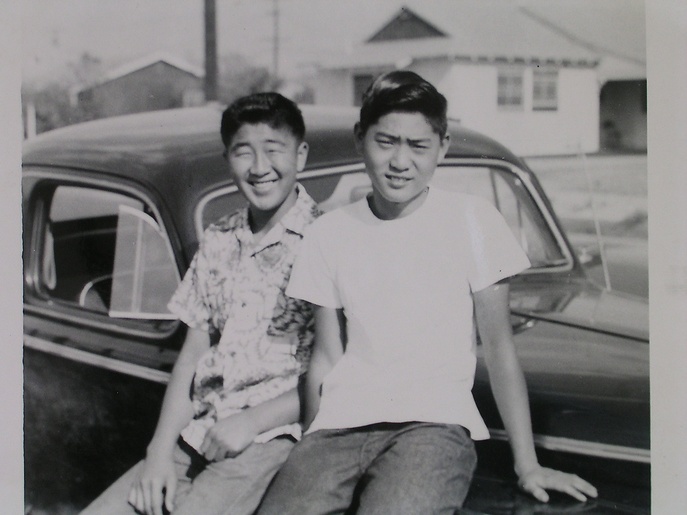
|
||
| Licensing | ||
“Telling Our Stories: Japanese Americans in the San Fernando Valley, 1910’s - 1970’s” unveils the forgotten past of Japanese Americans living in the San Fernando Valley. The history of the Japanese Americans in the San Fernando Valley is not well documented, despite their significant contributions. Approximately, 3,200 Japanese Americans lived in the San Fernando Valley, prior to their internment. Most were farming families who struggled to make a living in an era of intense racism. The Alien Land Act of 1913 along with local laws were just some of the attempts to limit where Japanese American farmers could farm, and maintain San Fernando Valley's predominately White population. Japanese American farmers were a major part of the California agricultural economy, growing various fruits, vegetables, as well as flowers. They were largely responsible for turning California’s “wasteland,” into the agricultural Mecca that it is known for today. After the bombing of Pearl Harbor, many were falsely suspected as being the enemy. Forced to evacuate, Japanese Americans experienced severe loss including land, property, and personal belongings. Family photos and documents were often buried, burned, or lost. After internment, many returned to their farms only to discover that their farms had been taken away or their property destroyed. Some continued to farm while others took on new professions such as gardening. Silence was a popular coping mechanism for moving on with their lives. This CSUN Asian American Studies service-learning project, working in partnership with the San Fernando Valley Japanese American Community Center uncovers this buried past through the collection of oral histories and rare family photographs. These stories add another chapter to California’s rich history.
Slides in this album |
|
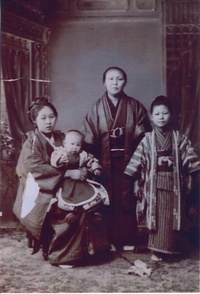
|
Migrating to AmericaIn 1885 a large number of Japanese immigrants arrived in Hawaii, soon after around the mid-1890’s many secondary-migrated to the U.S. Mainland. Of those who came to California, a large number settled in the San Fernando Valley.
Takeuchi Family Portrait in Japan, circa 1905 |
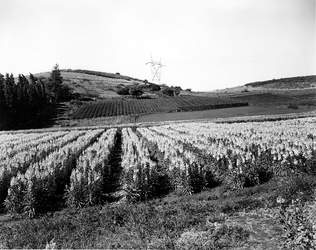
|
Farming in the San Fernando ValleyNonetheless, Japanese American farmers were highly successful despite law restrictions. They would lease or buy small plots of land, and specialize in crops that were labor-intensive. Japanese farmers grew produce such as raised bunch vegetables. (I.e., carrots, green onions, turnips, lettuce, cabbage, tomatoes, also a few farmers grew cantaloupes, strawberries … |
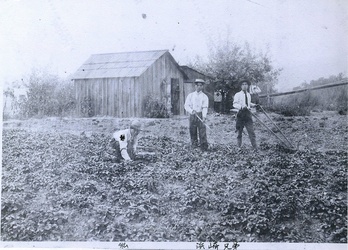
|
San Fernando Valley Then"Before the war, the Northridge area was mostly citrus, lemons, grapefruit, orange, and toward Canoga Park, it was mostly dry farm because they didn’t have any water facilities and that part of San Fernando Valley was the lowest part of San Fernando Valley, so in the winter it was called … |
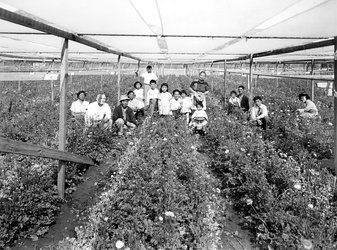
|
GardeningJapanese gardeners also thrived, growing flowers and plants other gardeners had little patience for. They found the climate in the San Fernando Valley was ideal for growing flowers. “Flowers we grew were either renunculas or anemones, which we grew in these cheesecloth tents that we would put up every … |
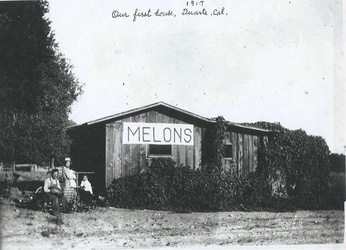
|
Life on the Farm"The one (house) in North Hollywood was a four-room shack. It had a sink, no built in’s, a refrigerator, or maybe an ice box, and then when we made a little money, we bought a cold spot Sears refrigerator, and then of course our toilet facilities were out housed, about …
Tsuneishi First Home, circa 1917 |
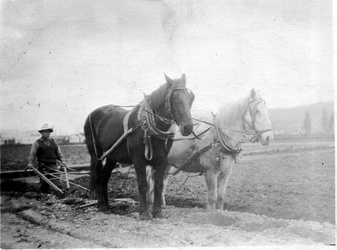
|
Life on the FarmMany farms were family run operations, often leasing land from European Americans. Other Japanese Americans were able to purchase land using their children's names, who were U.S. citizens. It was quite common for husband, wife, and children to all work in the fields. Some Japanese American families would also hire … |
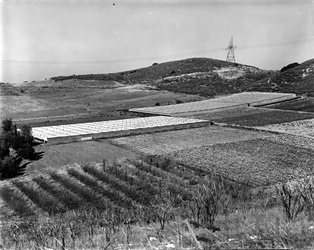
|
Settling in the San Fernando Valley, CABy the 1920’s the San Fernando Valley had become a large and successful agricultural center. Most Issei (first generation) and Nisei (second generation) were involved in the farming industry. However, due to the 1913 and 1920 California Alien Land Law, which restricted Japanese Americans from owning land, many Japanese farmers …
Aerial View of Kawakami Family Ranch |
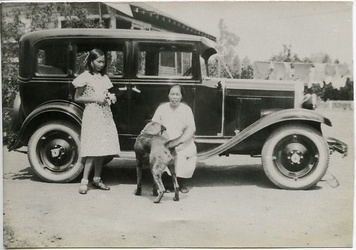
|
Tough TimesIt was real good getting a car during the depression, some guys weren’t eating too much and couldn’t find work”. ~Tamaru “Tom” Fujimoto
Kiju Fujimoto and daughter by car, circa 1930 |
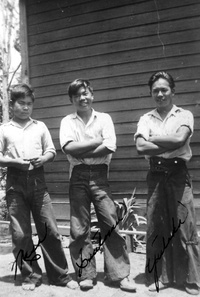
|
Where's Daddy?He [our father] got up 2 in the afternoon, and around 3 o’clock he left the house and went around the farm to pick up vegetables and loaded it into his car. He went to the market in LA where he distributed to the whole market. By midnight, he went …
3 brothers standing in front of house |
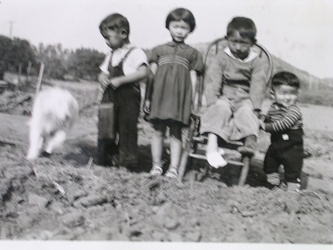
|
Women's Roles-No Time OffFarm life proved to be very difficult for many Japanese Americans in the San Fernando Valley, most working from sunrise to sundown. Many women juggled three full time roles: mother, wife and farmer.
"The women folk worked really hard. You know the saying they have about women…the work … |
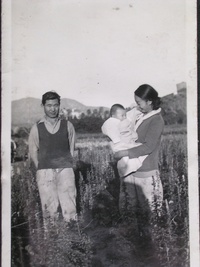
|
Dangerous Work"My mother had a stillborn. Before my youngest daughter was born and what cause that the doctor said was that she was out one day trying to scare the birds away from the crops, you know? Lettuce crops or something. She took a shotgun and fired to scare them, boom. … |

|
Japanese BathtubAfter a long days work on the farm, many Japanese Americans enjoyed relaxing in their traditional style "furo," bathtub. The bathtubs were usually located behind the house and used firewood to keep it warm. "My chore was to drain the tub outside the bathtub, clean it, fill it with water … |
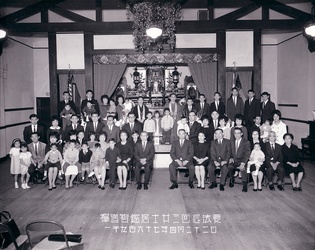
|
Community LifeWhen the Japanese first migrated to the mainland, many were encouraged to “westernize” by becoming Christians, however others strived to keep their own religion by the establishment of Buddhist temples and such. “I asked my parents, "You guys are Buddhist. Why did you send us to a Christian church? …
Memorial at Buddhist Temple 1964 |
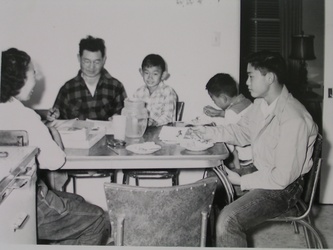
|
Home LifeAlthough there was a great deal of anti-Japanese sentiment due to labor competition and international relations, the Japanese Americans in the San Fernando Valley made it their home. They attended church, raised families, family excursions and merged their new western lifestyle with their traditional culture. "My mother used make like … |
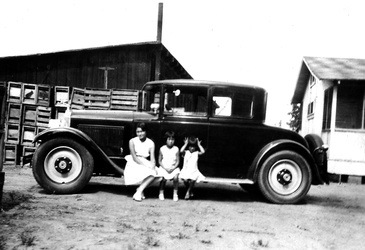
|
Health CareMy Parents told us never to go to the County hospital, because the Japanese get no help there. For example, there was a terrible flood and a White woman got covered with mud. The nurses ignored her because they thought she was Black or Mexican. After they washed the …
Mother and daughters with their car |

|
School in the San Fernando ValleyAnti-Japanese sentiment also affected the education of the Nisei and Sansei children. Some schools, specifically in northern California had segregated “Oriental Schools.” Japanese American children in the San Fernando Valley were not segregated but were usually only one or two in a classroom. “One of the Japanese Americans was … |
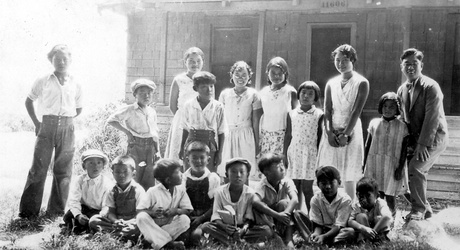
|
Japanese Language SchoolsOften feeling marginalized in “American” schools, many Japanese American children also joined Japanese Language Schools to socialize with other Japanese American children and learn Japanese language and traditions.
"(We went to) the Japanese Language because it was everyday after American school... and I really have to thank them … |
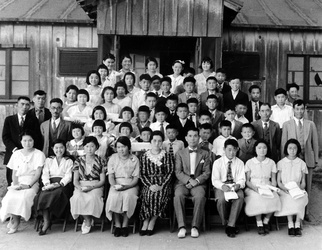
|
Japanese Language Schools"We had Japanese school in San Fernando. It was only one day a week though, on Saturdays only and I think we had regular class from maybe 9-3, or 8-4." ~Ritsuo Takeuchi |
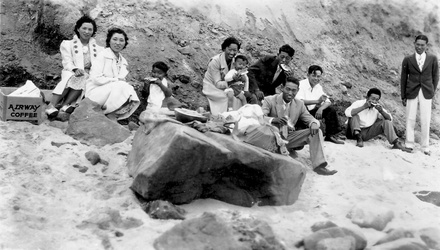
|
Family OutingsFor Japanese Americans, family outings were rare due to the fact that farm labor consumed most of their time. However, when the opportunity did arise, they were very much cherished, and the families often dressed in their best outfits.
Watanabe/Furuyama Family Picnic 1939 |

|
Picnics in the Valley“Going to the beach or having a picnic, everyone wore a suit and tie. When you went out in public, you wanted to look better.” ~ Bill Watanabe |
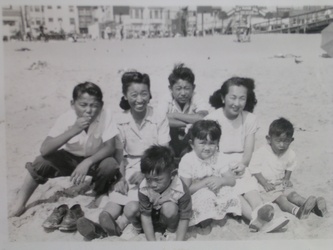
|
Leisure Time"The only time we ever got to go to the movies was on a holiday, the major holidays. And my mother didn't believe in playing cards. So we never had a deck of cards at home at all." ~ Bo T. Sakaguchi "You went to a theatre you … |
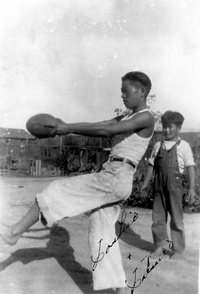
|
Leisure Time“Growing up in the valley back then, you had activities that weren’t planned. You could play sports in the backyard and the neighbors would come over. And we’d play baseball or throw a football around. We would have a lot of church group activities. We would go to the beach.” … |
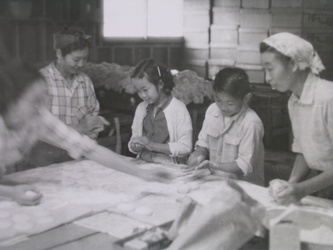
|
Japanese CelebrationsAlthough Japanese Americans wanted to be accepted in America, many felt strongly to hold to their Japanese cultural traditions, such as the Obon Festival, Boys Day, Girls Day, and New Year celebrations. New Year's day was especially looked forward to, as it was one of the few days they did …
Making Mochi: A New Year's Tradition circa 1955 |
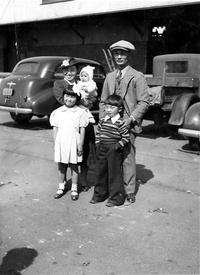
|
World War II-Leaving HomeAfter the bombing of Pearl Harbor in 1941 and the declaration of war against Japan, Executive Order 9066 was put into action and Japanese Americans on the West coast were forced to evacuate. With little notice, many people were forced to sell their belongings quickly, most for pennies on the … |
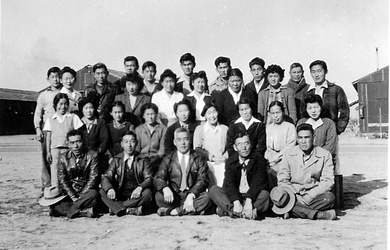
|
World War II-Internment CampsCamps were located in California, Arizona, Colorado, Wyoming, Utah, Arkansas, and Idaho. Out of those who went to camp 2/3 were Nisei, American-born and 1/3 were Issei. The average amount of time that they were interned was 2.5 years. "We sort of had an unconscious knowledge that we were … |
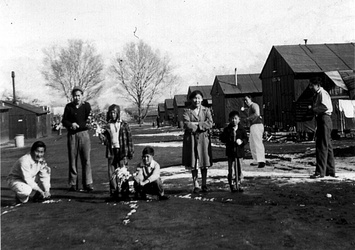
|
World War II-Internment Camps"It was very difficult. Apparently, the houses were ready and we came in busload. In May, Manzanar, it was cold and windy, the wind was just horrendous. We were given a mattress cover and we had to go to pile of hay and stuffed it in, and that was our … |
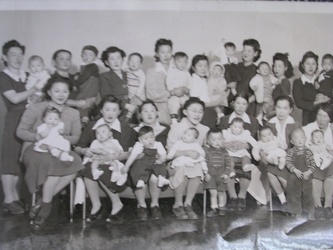
|
Tule LakeAmongst the internment camps across the county, Tule Lake was home to the those who were detained from other camps because they were thought to be potential enemies of America. Even many mothers and children were not exempt from this high security camp.
Tule Lake Internment Camp 1945 |
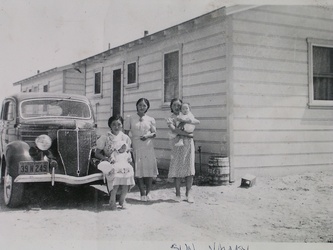
|
Lost FortunesDue to the swift and forced evacuation of the Japanese Americans in the San Fernando Valley many lost their homes, their vehicles, and other priceless artifacts such as photographs and family heirlooms. However, some who wanted to prove their loyalty to America disposed of any and all items that linked … |
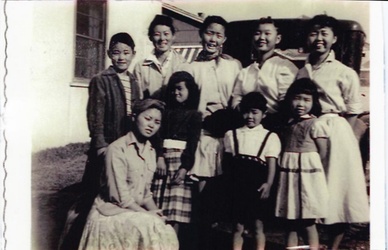
|
Brave ActsDespite the country's anti-Japanese sentiment, a few non-Japanese did reach out to assist and help Japanese Americans. Before being interned, some families left their cars and other valuables with their neighbors. Others were surprised by the unusual kindness of their Caucasian acquaintances during internment. "The only visitor I had … |
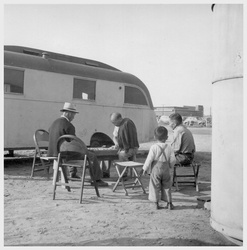
|
Rebuilding their livesAfter internment, many Japanese Americans originally from the San Fernando Valley, returned to find out that they no longer had a home to return to. Thereafter, trailer park camps, such as in Burbank and Sun Valley, became home to many Japanese Americans.
Burbank Trailer Park II, circa 1945 |
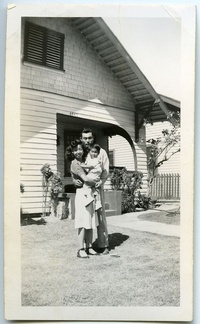
|
Finding a homeJapanese Americans were restricted from where they could live even after the war. It was quite common for real estate agents to show Japanese American homes in minority designated areas. “It was just known of the places you were allowed to go, and the places that you weren’t allowed, …
Tamaru "Tom" Fujimoto with wife and first son, circa 1945 |

|
Japanese American roots at Cal State University, NorthridgeThe Muranaka family settled in San Fernando Valley after the war and started farming. Shortly after, they Muranakas were forced to sell their land to Los Angeles City schools at a fraction of its value. Parts of California State University, Northridge and Porter Middle School was formerly their farmland. "My …
Aerial View of Kawakami Family Ranch |
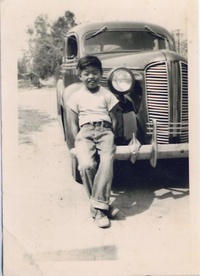
|
Gaman"Sure, there were discriminations; there are places where they hesitate to go, because my dad spoke very little English. My mother was a Nisei, she went to Grammar school where she spoke English very well. However, there was a certain amount of discrimination that was Gaman (endurance) and Shikataganai (accepting … |
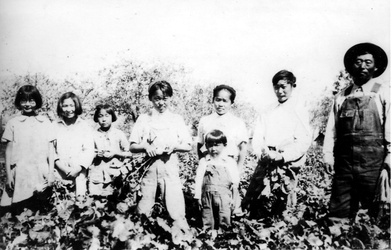
|
America is Our HomeDespite the hardships, discrimination, and trauma that the Issei and Nisei endured many are proud to call America their home because it is where they grew up or raised their families. |
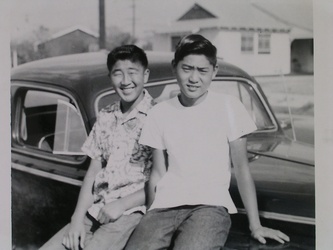
|
AcknowledgementsPrincipal Investigator: Edith Chen Community Director: Nancy Takayama Research Team-Cal State University Asian American Studies Students: Cecile Asuncion Teddy Avila Tiffany Cheng Jean-Paul deGuzman Eve Green Lindy Fujimoto Patricia Gopez Yen Hoang Amy Ikeda Ryan Ito Lori Monji Joseph Kim Scott Mitsunaga Caroline Moya Dinah Nghiem Peter … |
 CSUNAsianAmericanStudies
CSUNAsianAmericanStudies
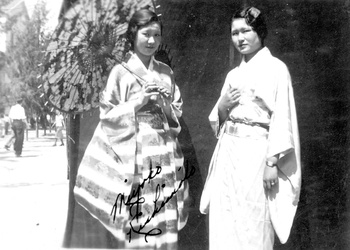
 Telling Our Stories: Japanese Americans in the San Fernando Valley, 1910's - 1970's
Telling Our Stories: Japanese Americans in the San Fernando Valley, 1910's - 1970's
 Journal feed
Journal feed
